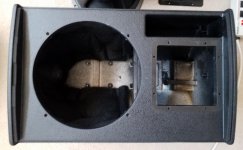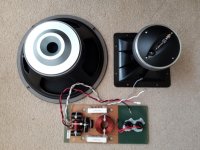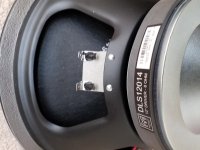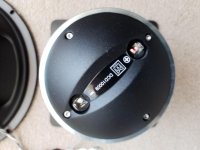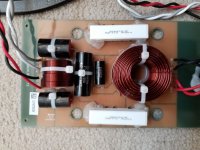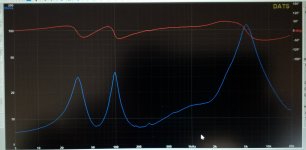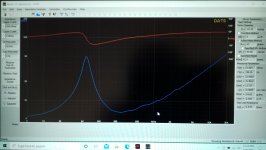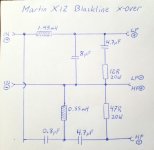Got my hands on a pair of Martin Blackline X12 pro speakers and decided to pull one of them apart to see inside as well as some basic measurements. If you're not familiar, this is their entry level 12" LF + 1" CD horn cab (assembled in China).
This speaker appears to use OE version Celestion drivers, likely made to Martin specs. The cabinet fit and finish is first class, considering this is a far east made product. Lots of nice CNC work went into it. The grille is secured with its own spring tension and rests in slots cut into the sides, so no screws used. The downside is removing them without marking up the exterior coating, since you have to pry against the woodwork to remove the grille. The enclosure has a decent amount of internal bracing and effectively helps minimize panel resonances (as seen in the system impedace plot). Lots of fly points available on all sides of the cab, so its very versatile. This makes a great floor wedge too, as you can rotate the waveguide for horizontal use.
First listening impressions are very good. They sound very balanced and actually very neutral for a PA cab, but the low end is a bit lean. They can play quite loud without signs of strain or harshness. For 650 bucks a piece, they are a hidden gem especially when compared to other passive cabs around that price point.
The crossovers are very well made and I'm impressed they only used metal film caps and air cored imductors, even on the LF low pass, so no core saturation or distortion as well as any electrolytics to deteriorate. The caps in series with the HF driver are PP while the parallel caps are MKT. Thats very smart cost cutting. The crossover circuit uses a 2nd order LP filter and 3rd order HP with CD compensation, which gets around using a resistor pad through a very small 0.8 uF cap in series, so in theory the HP is electrically more like a 2nd order design and apparently enough to flatten the upper HF with a slight rise in HF response past 10 kHz. Again, very clever.
Both LF and HF are clearly Celestion pieces. The HF driver looks internally and sounds like a CDX 1-1745. The non-metallic diaphragm makes for a smooth sound and reminds me alot of the popular B&C DE250 driver. There is no hint of harshness and you would be hard pressed to tell your listening to a compression driver on a CD horn. Not sure about the LF unit, as it doesn't measure or look like any of their off shelf models. The crossover point is around 2100 Hz. Thats a bit high for a 12" LF driver which will hurt off axis midrange, but it still sounds great. The cone appears to be made out of their Kevlar loaded paper formulation. Its a very stiff cone compared to other paper cone drivers. The surround is fairly narrow and won't facilitate larger amounts of cone excursion, however would help with midrange linearity.
Overall a great speaker, but really needs a sub to cover most of the range. Considering this, it's one of the better PA cabs I've heard under 1000 bucks. No, I'm not being paid to say this, just giving credit where it is due. Wondering if these could be improved upon through some basic tweaks ie. extra enclosure damping material.
This speaker appears to use OE version Celestion drivers, likely made to Martin specs. The cabinet fit and finish is first class, considering this is a far east made product. Lots of nice CNC work went into it. The grille is secured with its own spring tension and rests in slots cut into the sides, so no screws used. The downside is removing them without marking up the exterior coating, since you have to pry against the woodwork to remove the grille. The enclosure has a decent amount of internal bracing and effectively helps minimize panel resonances (as seen in the system impedace plot). Lots of fly points available on all sides of the cab, so its very versatile. This makes a great floor wedge too, as you can rotate the waveguide for horizontal use.
First listening impressions are very good. They sound very balanced and actually very neutral for a PA cab, but the low end is a bit lean. They can play quite loud without signs of strain or harshness. For 650 bucks a piece, they are a hidden gem especially when compared to other passive cabs around that price point.
The crossovers are very well made and I'm impressed they only used metal film caps and air cored imductors, even on the LF low pass, so no core saturation or distortion as well as any electrolytics to deteriorate. The caps in series with the HF driver are PP while the parallel caps are MKT. Thats very smart cost cutting. The crossover circuit uses a 2nd order LP filter and 3rd order HP with CD compensation, which gets around using a resistor pad through a very small 0.8 uF cap in series, so in theory the HP is electrically more like a 2nd order design and apparently enough to flatten the upper HF with a slight rise in HF response past 10 kHz. Again, very clever.
Both LF and HF are clearly Celestion pieces. The HF driver looks internally and sounds like a CDX 1-1745. The non-metallic diaphragm makes for a smooth sound and reminds me alot of the popular B&C DE250 driver. There is no hint of harshness and you would be hard pressed to tell your listening to a compression driver on a CD horn. Not sure about the LF unit, as it doesn't measure or look like any of their off shelf models. The crossover point is around 2100 Hz. Thats a bit high for a 12" LF driver which will hurt off axis midrange, but it still sounds great. The cone appears to be made out of their Kevlar loaded paper formulation. Its a very stiff cone compared to other paper cone drivers. The surround is fairly narrow and won't facilitate larger amounts of cone excursion, however would help with midrange linearity.
Overall a great speaker, but really needs a sub to cover most of the range. Considering this, it's one of the better PA cabs I've heard under 1000 bucks. No, I'm not being paid to say this, just giving credit where it is due. Wondering if these could be improved upon through some basic tweaks ie. extra enclosure damping material.
Attachments
Working on FR response measurements and will post when I can.
If anyone has tips regarding the small lower midrange peaks around 180 and 300 Hz (see impedance plot), please let me know. Lack of cabinet dampening material? I doubt they are panel resonances since the enclosures are braced very well and pass the knuckle test to my ears.
If anyone has tips regarding the small lower midrange peaks around 180 and 300 Hz (see impedance plot), please let me know. Lack of cabinet dampening material? I doubt they are panel resonances since the enclosures are braced very well and pass the knuckle test to my ears.
Last edited:
Cabinet height is directly connected to 280 Hz resonance seen in impedance graph. Damping material appears insufficient to suppress one and there may be potential to improving the crossover network if acoustic centre of the tweeter is in fact behind the woofer's.
I was suspecting that, but didn't think that in itself would make it show up that severe in the impedance plot.
Would it be better to place denser dampening material (mineral wool) at the bottom of the cab (closer to LF driver) or less dense material (poly fill) in the middle at the bracing? I don't want to impede airflow to the port. Assuming the high pressure area being at the upper/lower enclosure boundaries and LF driver location itself, maybe a layer of mineral wool in those areas would be sufficient?
I appreciate the input and figured it would be a process of experimentation. I generally don't deal with ported enclosures since these need specific dampening to avoid port efficiency reduction, plus I don't like the midrange coloration most ported designs have. I'll just need to measure port output to verify any problems in this area. A sealed cab is so much easier to dampen.
Casual listening did reveal some weirdness in the low mids, which prompted me to take a closer look at the inner workings. Maybe there is also interaction with the woofer LP inductor - not sure if the LF driver magnet distance is sufficient. It may not be worth improving these small issues for most people, but I can't deal with lower midrange coloration. It really bugs me the most aside from HF driver response peaks/distortion. Hopefully there is a decent compromise to be struck with simple mods.
Casual listening did reveal some weirdness in the low mids, which prompted me to take a closer look at the inner workings. Maybe there is also interaction with the woofer LP inductor - not sure if the LF driver magnet distance is sufficient. It may not be worth improving these small issues for most people, but I can't deal with lower midrange coloration. It really bugs me the most aside from HF driver response peaks/distortion. Hopefully there is a decent compromise to be struck with simple mods.
Both resonances are present at the port opening. Adding poly fill to the upper and lower inside walls improved things a bit and made the peaks almost vanish from the impedance curve. This cleaned the midrange up and actually made the low end sound tighter. Some of the low end punch is gone, which was predictable. Most manufacturers likely prefer to use less dampening to get the most low end possible rather than have cleaner midrange output at expense of low end efficiency.
I'm also going to see how much the grilles affect the sound. I can't imagine they will help at all being they're perforated metal. At least they dont appear to add any weird resonances.
I'm also going to see how much the grilles affect the sound. I can't imagine they will help at all being they're perforated metal. At least they dont appear to add any weird resonances.
Hi, nice post! Always exited to see what the other end is cooking  . (Pro vs. DIY).
. (Pro vs. DIY).
From viewing the driver could be a OEM version of the 1225e the one with the most xmax, of their Mid/Bass portfolio, with 3,5 mm. Which fits the power suggestion of 300 Watts AES which is the same as the 1225e states.
The Ht can be an OEM of the CDX1-1745 cause they claim the x-over for the X12 is around 2,3 khz.
But tested the LF, with an estimated guess of the vb of the X12 and the length and size of the port of your fotos plus the reversed engineered crossover, i do not see where this should arrive at 2,3 khz.
Plus its a bit humpy around 100-150 hz, cause the cab is to small.
With more accurate specs of the driver itself and the cab i could model more detailed, but so far so good.
Like i said always nice to see whats behind the cab-curtin!
Greets Swany
From viewing the driver could be a OEM version of the 1225e the one with the most xmax, of their Mid/Bass portfolio, with 3,5 mm. Which fits the power suggestion of 300 Watts AES which is the same as the 1225e states.
The Ht can be an OEM of the CDX1-1745 cause they claim the x-over for the X12 is around 2,3 khz.
But tested the LF, with an estimated guess of the vb of the X12 and the length and size of the port of your fotos plus the reversed engineered crossover, i do not see where this should arrive at 2,3 khz.
Plus its a bit humpy around 100-150 hz, cause the cab is to small.
An externally hosted image should be here but it was not working when we last tested it.
With more accurate specs of the driver itself and the cab i could model more detailed, but so far so good.
Like i said always nice to see whats behind the cab-curtin!
Greets Swany
Overall construction looks similar to my powered EAW RS153. It could use a little more bracing and damping. A high end neo 15" replacement wouldn't hurt either.
It has nearly perfect phase and frequency response down to 100hz with very good directivity.
I use it as a reference for my other projects.
It has nearly perfect phase and frequency response down to 100hz with very good directivity.
I use it as a reference for my other projects.
Thanks for the replies. Ive been preoccupied with health issues so I haven't been able to do any more forensics.
I agree the woofer is probably an oem 1225e, but the surround is different. Maybe they did this to keep the motor from bottoming to early, trying to avoid warranty issues, but it does hurt low end linearity somewhat.
The bumpiness is for sure a combination of cabunet shape, dimensional proportions and lack of good dampening combined with port output. The low mid weirdness is my biggest pet peve with this speaker. I can tolerate alot, but cabinet/resonance problems bug me the most. Doing a static sweep with my hands on the cab, I can feel excess movement mostly in the front baffle but also to a lesser degree around the port walls. That unsupported outside wall of the port needs more bracing. There are also some peaks in the acoustic output from the port.
That small 0.8uF cap doing the CD shelf eq causes a huge impedance peak in the mids. I'm sure they did that to save money. The top end is pretty good given its a budget HF driver and CD horn with parallel walls in the throat area. There is also a fairly big discrepancy between both woofer's specs and it shows up in the impedance sweep. Still pretty good for a budget PA speaker, especially comparing most off the shelf junk you can get from a place like Guitar Center.
I agree the woofer is probably an oem 1225e, but the surround is different. Maybe they did this to keep the motor from bottoming to early, trying to avoid warranty issues, but it does hurt low end linearity somewhat.
The bumpiness is for sure a combination of cabunet shape, dimensional proportions and lack of good dampening combined with port output. The low mid weirdness is my biggest pet peve with this speaker. I can tolerate alot, but cabinet/resonance problems bug me the most. Doing a static sweep with my hands on the cab, I can feel excess movement mostly in the front baffle but also to a lesser degree around the port walls. That unsupported outside wall of the port needs more bracing. There are also some peaks in the acoustic output from the port.
That small 0.8uF cap doing the CD shelf eq causes a huge impedance peak in the mids. I'm sure they did that to save money. The top end is pretty good given its a budget HF driver and CD horn with parallel walls in the throat area. There is also a fairly big discrepancy between both woofer's specs and it shows up in the impedance sweep. Still pretty good for a budget PA speaker, especially comparing most off the shelf junk you can get from a place like Guitar Center.
Sounds about the same as my main complaints for the EAW.
Great for the price though. A similar sized box with a premium woofer and Baltic birch construction can easily cost 2.5 times more.
I did drop in a BMS 15" just to hear the difference. Lower measured distortion at higher levels than the stock woofer. Sounded cleaner as well.
I do not like this box as a bass guitar monitor. Plenty of low end but can never get a nice tight sound out of it and the processing reacts strangely. Sounds great for music playback.
Thanks for starting this thread. Hope you feel better!
Great for the price though. A similar sized box with a premium woofer and Baltic birch construction can easily cost 2.5 times more.
I did drop in a BMS 15" just to hear the difference. Lower measured distortion at higher levels than the stock woofer. Sounded cleaner as well.
I do not like this box as a bass guitar monitor. Plenty of low end but can never get a nice tight sound out of it and the processing reacts strangely. Sounds great for music playback.
Thanks for starting this thread. Hope you feel better!
Last edited:
- Home
- Loudspeakers
- Multi-Way
- Martin X12 Blackline pro 2 way speaker evaluation
